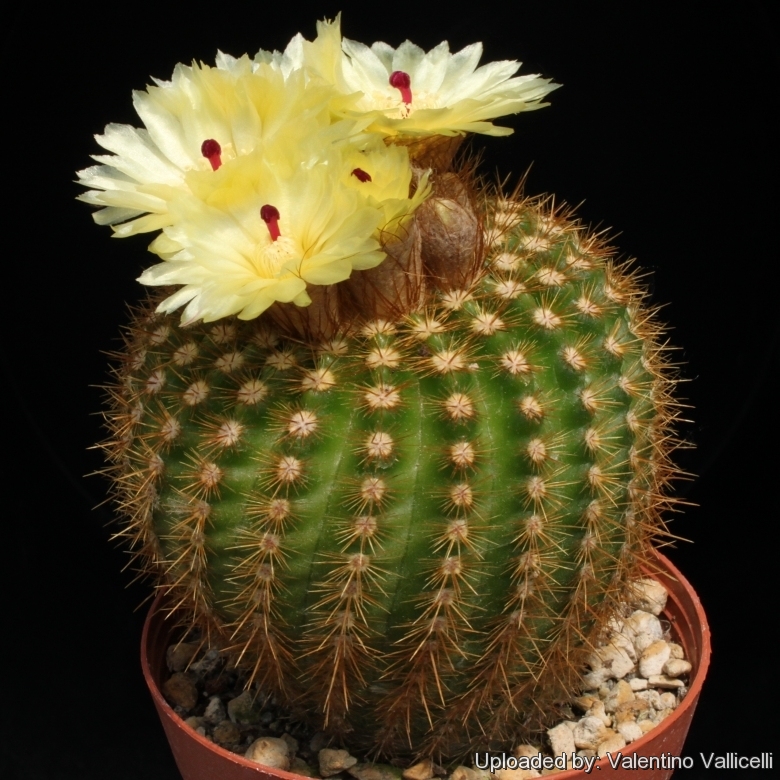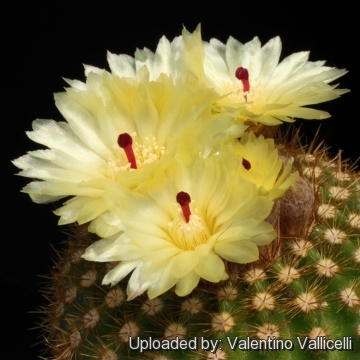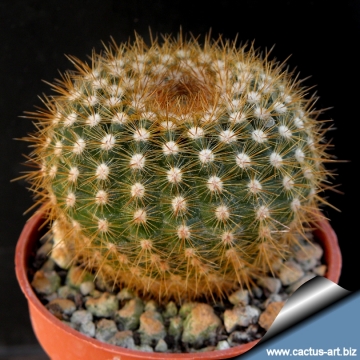




Your support is critical to our success.

Origin and Habitat: Sao Gabriel, Rio Grande do Sul, Brazil.
Habitat: It occurs in grasslands. Droughts are not severe or prolonged, and the numerous low ribs provide enough expansion capacity that stems swell enough to store moderate amounts of water. Due to the large number of ribs, no rib has to expand very much after a rain.
Synonyms:
- Parodia scopa subs. succinea (F.Ritter) Hofacker & P.J.Braun
- Notocactus scopa subs. succineus (F.Ritter) Doweld
- Notocactus scopa f. succineus (F.Ritter) N.Gerloff & Neduchal
- Notocactus succineus F.Ritter
- Parodia succinea (F.Ritter) N.P.Taylor
- Peronocactus scopa subs. succineus (F.Ritter) Doweld
Parodia scopa subs. succinea (F.Ritter) Hofacker & P.J.Braun
Cactaceae Consensus Init. 6: 10. 1998
Synonymy: 14
- Parodia scopa subs. succinea (F.Ritter) Hofacker & P.J.Braun
- Notocactus scopa subs. succineus (F.Ritter) Doweld
- Notocactus scopa f. succineus (F.Ritter) N.Gerloff & Neduchal
- Notocactus succineus F.Ritter
- Parodia succinea (F.Ritter) N.P.Taylor
- Peronocactus scopa subs. succineus (F.Ritter) Doweld
- Parodia scopa subs. succinea f. albiseta hort.
- Notocactus scopa var. albispinus hort.
- Notocactus succineus var. albisetus hort.
- Notocactus succineus var. albispinus hort.
- Parodia scopa f. albiseta hort.
- Parodia scopa var. sulphurea hort.
Parodia scopa (Spreng.) N.P.Taylor
Bradleya 5: 93. 1987
Synonymy: 38
- Parodia scopa (Spreng.) N.P.Taylor
- Cactus scopa Spreng.
- Cereus scopa (Spreng.) Salm-Dyck ex DC.
- Echinocactus scopa (Spreng.) Link & Otto
- Echinopsis scopa (Spreng.) Carrière
- Malacocarpus scopa (Spreng.) Britton & Rose
- Notocactus scopa (Spreng.) A.Berger
- Peronocactus scopa (Spreng.) Doweld
- Notocactus scopa f. albicans (Arechav.) N.Gerloff & Neduchal
- Echinocactus scopa var. albicans Arechav.
- Echinocactus scopa f. albicans (Arechav.) Schelle
- Notocactus scopa var. albicans (Arechav.) Hofacker
- Notocactus scopa f. albilanatus Jahn
- Notocactus scopa f. candidus (Pfeiff.) Krainz
- Echinocactus scopa var. candidus Pfeiff.
- Echinocactus scopa f. candidus (Pfeiff.) Schelle
- Notocactus scopa var. candidus (Pfeiff.) Backeb.
- Notocactus scopa f. cobrensis (N.Gerloff) N.Gerloff & Neduchal
- Notocactus scopa var. cobrensis N.Gerloff
- Notocactus scopa f. daenikerianus (Krainz) Krainz
- Notocactus scopa f. erythrinus Havlíček
- Notocactus scopa f. glauserianus (Krainz) Krainz
- Notocactus scopa f. machadoensis (W.R.Abraham) N.Gerloff & Neduchal
- Notocactus scopa var. machadoensis W.R.Abraham
- Notocactus scopa var. murielii Hofacker
- Notocactus scopa f. ramosus (Osten) Backeb.
- Echinocactus scopa f. ramosus Osten
- Notocactus scopa var. ramosus (Osten) Backeb.
- Notocactus scopa f. ruberrimus Frič
- Notocactus scopa f. xicoi (W.R.Abraham) N.Gerloff & Neduchal
- Notocactus scopa var. xicoi W.R.Abraham
- Notocactus scopa f. xiphacanthus (W.R.Abraham) N.Gerloff & Neduchal
- Notocactus scopa var. xiphacanthus W.R.Abraham
- Notocactus soldtianus Vliet
- Parodia scopa f. cristata hort.
- Parodia scopa f. splendens hort.
Parodia scopa subs. marchesii (W.R.Abraham) Hofacker
Cactaceae Consensus Init. 6: 12. 1998
Synonymy: 5
- Parodia scopa subs. marchesii (W.R.Abraham) Hofacker
- Notocactus scopa subs. marchesii (W.R.Abraham) Doweld
- Notocactus scopa var. marchesii W.R.Abraham
- Notocactus scopa f. marchesii (W.R.Abraham) N.Gerloff & Neduchal
- Peronocactus scopa subs. marchesii (W.R.Abraham) Doweld
Parodia scopa subs. neobuenekeri (F.Ritter) Hofacker & P.J.Braun
Cactaceae Consensus Init. 6: 10. 1998
Synonymy: 5
- Parodia scopa subs. neobuenekeri (F.Ritter) Hofacker & P.J.Braun
- Notocactus neobuenekeri F.Ritter
- Notocactus scopa subs. neobuenekeri (F.Ritter) Doweld
- Parodia neobuenekeri (F.Ritter) Anceschi & Magli
- Peronocactus scopa subs. neobuenekeri (F.Ritter) Doweld
Description: Parodia scopaSN|15897]]SN|15897]] subs. succinea, best known as Notocactus succineusSN|15907]]SN|15907]], is one of the varieties of the wide ranging and very variable Parodia scopaSN|15897]]SN|15897]] distinguished for its smaller stems with abundant dark yellow central spines. It has about 18-24 ribs, 8-12 central spines, and 15-30 radials. The flowers are very showy, glossy yellow.
Habit: It is perennial stem succulent branching from the base. This variety ends up forming very big clumps when age.
Stem: Dark green, at first globular, becoming bit columnar to clavate with age, depressed apically, 2,5-7 cm in diameter.
Ribs: 18-24 (sometime up to 28 or more) low, obtuse, finely notched into low warts tipped with areoles, which may spiral slightly.
Areoles: White woolly.
Central spines: About 4 to 12 dark yellow, brownish or violet, medium length, needle-like, stouter than radials.
Radial spines: (12-)15-30(-40) shorter, fine, bristles-like, whitish, yellowish, or brownish 3-10 mm long, spreading around.
Flowers: A cluster of satiny, bright yellow flowers spring in the upper part of the stem forming a ring, The are 3-3,6 cm long and 3-4 cm in diameter. Inner perianth segments in two overlapping series, spatulate, rather wide for their length, more or less toothed above, Pistil with about 10, rayed, bright crimson stigma lobes. Tube short. Scales on the ovary woolly with brown bristles.
Blooming season: June-July.
Fruits: Globose, about 7 mm in diameter, opening at maturity, with numerous seeds.
Seeds: Dull black tuberculate 0,6-0,9 x 0,5-1 mm broad.
Subspecies, varieties, forms and cultivars of plants belonging to the Parodia scopa group
 Notocactus scopa f. cobrensis (N.Gerloff) N.Gerloff & Neduchal: has dark-red central spines and shorter white spines and wool around. It is very slow growing. Distribution: Rio Grande do Sul (Brazil)
Notocactus scopa f. cobrensis (N.Gerloff) N.Gerloff & Neduchal: has dark-red central spines and shorter white spines and wool around. It is very slow growing. Distribution: Rio Grande do Sul (Brazil) Notocactus scopa var. murielii Hofacker: has silvery spined stems. Distribution: Uruguay.
Notocactus scopa var. murielii Hofacker: has silvery spined stems. Distribution: Uruguay. Notocactus scopa f. xicoi (W.R.Abraham) N.Gerloff & Neduchal: has fewer ribs and fewer spines. Particularly striking are the numerous purple brown central spines. Distribution: Pedras Altas and Herval, Rio Grand do Sul, Brazil.
Notocactus scopa f. xicoi (W.R.Abraham) N.Gerloff & Neduchal: has fewer ribs and fewer spines. Particularly striking are the numerous purple brown central spines. Distribution: Pedras Altas and Herval, Rio Grand do Sul, Brazil. Notocactus scopa f. xiphacanthus (W.R.Abraham) N.Gerloff & Neduchal: has larger stems with fewer ribs and usually a long, dark, sword-shaped central spine. Distribution: Minas, Lavalleja, Uruguay.
Notocactus scopa f. xiphacanthus (W.R.Abraham) N.Gerloff & Neduchal: has larger stems with fewer ribs and usually a long, dark, sword-shaped central spine. Distribution: Minas, Lavalleja, Uruguay. Parodia scopa (Spreng.) N.P.Taylor: has stems with 30-40 ribs, about 4 central spines, and 40 or more radials. Distribution: Southern Brazil and Paraguay.
Parodia scopa (Spreng.) N.P.Taylor: has stems with 30-40 ribs, about 4 central spines, and 40 or more radials. Distribution: Southern Brazil and Paraguay. Parodia scopa f. cristata hort.: Crested form.
Parodia scopa f. cristata hort.: Crested form.- Parodia scopa subs. marchesii (W.R.Abraham) Hofacker: has stems with fewer ribs (19-28), 2-4 white or yellowish central spines, and about 40 radials. Distribution: Treinta y Tres, Uruguay.
- Parodia scopa subs. neobuenekeri (F.Ritter) Hofacker & P.J.Braun: stems with 18-21ribs, 6-12 strong central spines, and 30-40 radials. Distribution: near Camaqua, Rio Grande do Sul, Brazil.
 Parodia scopa f. splendens hort.
Parodia scopa f. splendens hort. Parodia scopa subs. succinea (F.Ritter) Hofacker & P.J.Braun: has stems with 18-24 ribs, 8-12 central spines, and 15-30 radials. Distribution: near Sao Gabriel, Rio Grande do Sul, Brazil.
Parodia scopa subs. succinea (F.Ritter) Hofacker & P.J.Braun: has stems with 18-24 ribs, 8-12 central spines, and 15-30 radials. Distribution: near Sao Gabriel, Rio Grande do Sul, Brazil. Parodia scopa subs. succinea f. albiseta hort.: has pure white spines.
Parodia scopa subs. succinea f. albiseta hort.: has pure white spines. Parodia scopa var. sulphurea hort.: This is only a common hoticultural name for "Parodia scopa ssp. succinea"
Parodia scopa var. sulphurea hort.: This is only a common hoticultural name for "Parodia scopa ssp. succinea" Parodia scopa cv. inermis: has spineless areoles with a short white wool, they are arranged geometrically and contrast with the stem. A few small bristly spines are occasionally produced in the flowering areoles.
Parodia scopa cv. inermis: has spineless areoles with a short white wool, they are arranged geometrically and contrast with the stem. A few small bristly spines are occasionally produced in the flowering areoles. Parodia scopa cv. inermis cristata: Crested form.
Parodia scopa cv. inermis cristata: Crested form.
Bibliography: Major references and further lectures
1) Edward Anderson “The Cactus family” Timber Press, Incorporated, 2001
3) James Cullen, Sabina G. Knees, H. Suzanne Cubey "The European Garden Flora Flowering Plants: A Manual for the Identification of Plants Cultivated in Europe, Both Out-of-Doors and Under Glass" Cambridge University Press, 11/Aug/2011
4) David R Hunt; Nigel P Taylor; Graham Charles; International Cactaceae Systematics Group. "The New Cactus Lexicon" dh books, 2006
5) Friedrich Ritter “Kakteen in Suedamerika: Ergebnisse Meiner 20 Jaehrigen Feldforschungen” F. Ritter Selbstverlag, 1979
6) Hiroshi Hirao “Colour encyclopaedia of cacti” Seibundo Shinkosha, 1979
7) Jan Říha, Rudolf Šubík, Gillian Beckett “The Illustrated Encyclopedia of Cacti & Other Succulents” Octopus Publishing Group, 1981
8)Mariella Pizzetti, Giuseppe Mazza “Piante grasse: le cactacee” A. Mondadori, 1985

Parodia scopa subs. succinea Photo by: Valentino Vallicelli

Parodia scopa subs. succinea Photo by: Cactus Art
Cultivation and Propagation: It is easy to grow. It prefers a neutral to slightly acidic mineral-based potting mix with plenty of extra grit and feed during the summer. It likes a warm bright location, does great in partial shade but doesn't like full, hot blazing sun in the central summer month. Can support quite some water during the growing season but pot plants in winter are wet-sensitive and needs to be kept dry (rots easily if soil is wet and cold) tends to lose its roots in winter. Water Best if watered with rain water. Usually it is recommended to over-winter this plant in a bright and warm greenhouse with at least 8-10° C and rather dry (it tends to lose its roots and to rot if the substrate is wet and cold) but it has proved to tolerate temperatures as low as -5° C for short periods. It is susceptible to spider mites, so it should be check once in a while for it.
Propagation: Seeds, cuttings or root suckers (if available). Not too difficult to raise from seed.
| Your Actions | |
|---|---|
| Back to Parodia index | |
| Back to Cactaceae index | |
 |
Back to Cacti Encyclopedia index |
Privacy stantement - Terms and conditions - How to cite - About us - Feedback - Donate



